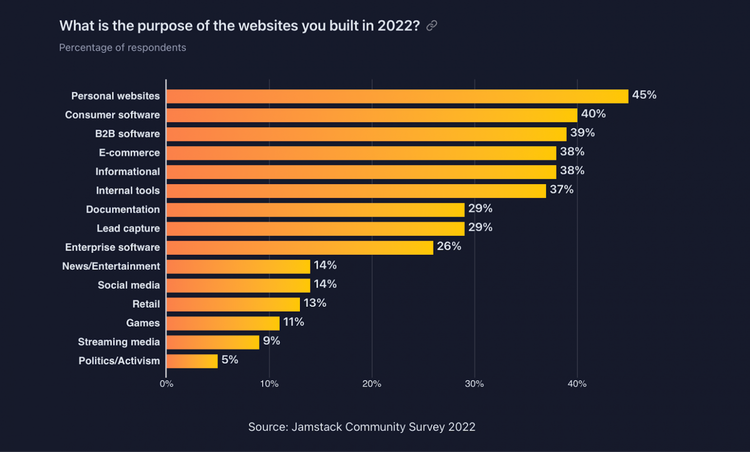This report provides a thorough analysis of the utilization of Jamstack architecture in website development through case studies of companies across various domains. The research delves into the drivers, architectural choices, results, hurdles, and recommended approaches for integrating Jamstack technology.
What is Jamstack?
Jamstack is a robust web development architecture crafted to build secure, faster, and scalable web applications. It comprises three key elements of development: JavaScript, API, and Markup (JAM).
JavaScript – It manages all the dynamic aspects and features of the Jamstack website. Developers can effortlessly utilize their preferred framework to develop web applications.
APIs – By employing reusable APIs, server-side operations are optimized for user interface (UI) and application backend connectivity.
Markup – Users experience the Jamstack website through HTML files. This means that these files can be generated from structured data formats like XML, Markdown, JSON, or directly from source files using a static website generator.
As a result, users benefit from a speedy application experience, while CEOs or CTOs can optimize development costs effectively, and Jamstack developers can create applications at a reduced expense.
Choosing a subject matter case study
Here are some examples of organizations using Jamstack:
- Netlify is a cloud-based platform that provides a server-side architecture for web development. It is a key member of the Jamstack ecosystem, providing developers with tools to build and deploy Jamstack-based applications.
- GitHub is a web-based platform for version control and collaborative software development. It is widely used for hosting and managing source code repositories. GitHub Pages, a feature of GitHub, uses the Jamstack architecture to allow users to host static websites directly from their GitHub repositories.
- Shopify is an e-commerce platform that allows companies to create online shops. It provides tools for managing products, orders, and customer interactions. Shopify has implemented Jamstack principles to improve the performance and security of online shops by using static site generators for certain parts of its infrastructure.
- Braintree (a PayPal company) is a payment processing platform that allows businesses to accept, process and share payments. Braintree uses Jamstack principles to optimize the performance and security of its online documentation and developer resources.
Data Collection
A study was conducted to gain insights into the motivations, architectural decisions, and outcomes of implementing Jamstack architecture in organizations. The following are the main aspects highlighted from the analysis:
Motivations for Jamstack implementation:
The primary motivation for implementing Jamstack is to improve performance and security. Many organizations are adopting Jamstack to improve page load speed while reducing vulnerability to specific attacks.
Jamstack Architecture Solutions:
Many companies prefer to use statically generated websites (SSGs) in their web development process because they demonstrate excellent performance and simplify maintenance processes. SSGs pre-generate content, allowing for the quick delivery of finished pages to users. Additionally, Client-Side Rendering (CSR) is applied in some scenarios, providing dynamic updating of content on the client side. This enhances the interactivity of web applications, making the user experience more dynamic and engaging.
Organizations are also successfully integrating reusable APIs for efficient data exchange between the UI and the backend. This enables efficient information management by ensuring smooth and consistent data exchange, which is important for the functionality and performance of web applications as a whole.
Jamstack Implementation Results:
Many companies are noticing that users are becoming more satisfied with fast load times and easy navigation on their websites. Plus, using statically generated sites and content delivery networks (CDNs) helps reduce server load, positively impacting scalability and maintenance.
These benefits highlight the advantages companies gain by moving to a Jamstack architecture. It also provides other companies with information to make informed decisions when choosing technologies for web development.
Architecture Analysis
Analyzing the architecture components and technologies used in Jamstack applications involves examining static site generators, content APIs, and serverless features.
Static Site Generators (SSGs) are crucial in constructing modern web applications. Their primary advantage lies in pre-generating static pages during the application build process. This approach notably enhances the loading speed and overall performance of the site. Popular tools like Gatsby, Next.js, and Hugo offer developers convenient solutions for creating statically generated sites, ensuring an efficient and user-friendly development experience.
Content APIs play a pivotal role in facilitating dynamism in static applications. Reusable APIs are utilized to fetch and modify data, enabling the provision of dynamic content on the client side. Examples of such APIs include Contentful, Strapi, and GraphQL APIs. These tools empower efficient content management, allowing developers to manipulate data and craft a dynamic user experience.
Serverless functions represent another crucial component of the Jamstack architecture. They enable the execution of server-side code without the requirement for infrastructure management. This approach offers scalability and resource efficiency, as functions are triggered only when necessary. Prominent tools for developing and deploying serverless functions include AWS Lambda, Azure Functions, and Netlify Functions.
In this way, static site generators, content APIs, and serverless functions come together in the Jamstack architecture to provide efficient and productive web application creation. Overall, Jamstack offers significant performance, security and scalability benefits, making it an attractive choice for modern web applications.
Even more intriguingly, there is a high demand for Jamstack developers across various industries, such as finance, healthcare, marketing, education, and advertising. This indicates that Jamstack has reached a mature stage of adoption. As headless CMS platforms mature, Jamstack builds are gaining popularity even among large corporations. Indeed, Jamstack serves as a web development solution that bridges the application gap, catering to the needs of multi-million dollar companies.

Development process and tools
Development Process:
- Local Work: Developers test their websites on their own computers.
- Data Interaction: Applications get the information they need through APIs, making their work easier.
Automation Tools:
- Git: Uses Git to collaborate and improve code.
- CI/CD: Continuous Integration/Continuous Deployment (CI/CD) systems ensure stable changes.
Deployment Strategies:
- Fast and Everywhere: Pages load quickly thanks to a content delivery network (CDN) distribution.
- Serverless Functions: Fast and instant functions handle tasks instantly.
In Jamstack, the end product for the user is a static HTML page. Page templates and data are stored separately. Static page generators (SSGs) are used to create pages based on templates without data. The data is stored in the Headless CMS, and using an API, the SSG connects to the CMS, generating static HTML pages. The code is then placed in a remote repository, and a service like Netlify takes the code, runs it, and hosts the resulting HTML pages.
Jamstack makes development simpler and more efficient, enabling easy collaboration and high performance web applications.
| Jamstack | Outdated system |
|---|---|
| Jamstack technologies like Gatsby and Next.js are written in JavaScript, one of the most popular programming languages. | Outdated solutions like Drupal and WordPress are written in PHP, one of the oldest programming languages. |
| The Jamstack template has ready-made modules that help developers build applications faster with optimal development costs and minimal effort. | Maintaining old code demands significant time, energy, financial resources, and the effort required to upgrade legacy systems to more recent versions. |
| Jamstack eliminates all the security concerns that age-old development architectures have. | Outdated systems lack the necessary security, application management tools, and technology. |
Programming languages
Data on the popularity of programming languages in the Jamstack community
JavaScript remains a nearly universal choice, with 96% of respondents stating that they have utilized it in some or multiple projects within the past year.

Jamstack is an ecosystem that allows the JavaScript framework, template markup, and APIs to work in full synchronization to develop a fast and scalable website. This makes speed one of the main benefits of Jamstack that a marketer can utilize.
Learned Lessons and Recommendations
The Jamstack application study identified key lessons learned, including the use of modern tools and optimization strategies. Recommendations include examining approaches to technology selection, performance monitoring, and team preparation for Jamstack principles. They will help organizations effectively implement and use this architecture.








